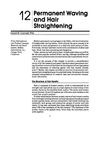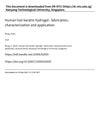TLDR Keratin films from human hair can potentially replace human nail plates for drug testing.
The study developed a keratin film from human hair as a substitute for human nail plates to study drug permeation. The film demonstrated mechanical stability and water resistance, making it suitable for permeation experiments. It showed similar permeability to bovine hooves, particularly for hydrophilic substances, suggesting its potential as a human nail plate model. However, the use of lipophilic drugs and penetration enhancers required careful interpretation.
226 citations
,
January 2002 in “Biological and Pharmaceutical Bulletin” A new method quickly extracts and identifies proteins from hair and other keratin sources.
150 citations
,
July 2001 in “Clinics in dermatology” Proper haircare and communication with doctors are key to managing hair loss and avoiding damage.
10 citations
,
May 1994 in “Journal of Investigative Dermatology” 36 citations
,
December 1991 in “Journal of Dermatological Science” Human nails contain both skin and hair keratins, each needing different extraction methods.
 20 citations
,
July 1988 in “Clinics in dermatology”
20 citations
,
July 1988 in “Clinics in dermatology” Thioglycolate lotions are the most popular method for permanent waving and hair straightening.
29 citations
,
December 2021 in “Pharmaceutics” Phospholipid soft vesicles improve topical drug delivery for better skin condition treatments.
115 citations
,
August 2014 in “Jo'jig gonghag gwa jaesaeng uihag/Tissue engineering and regenerative medicine” Human hair keratin can be used in many medical applications.

Keratin hydrogels from human hair show promise for tissue engineering and regenerative medicine.
22 citations
,
August 2015 in “PloS one” Keratin from hair binds well to gold and BMP-2, useful for bone repair.
 30 citations
,
March 2017 in “ACS biomaterials science & engineering”
30 citations
,
March 2017 in “ACS biomaterials science & engineering” Hair follicles are valuable for regenerative medicine and wound healing.


